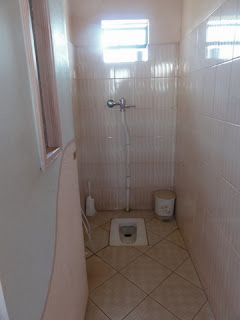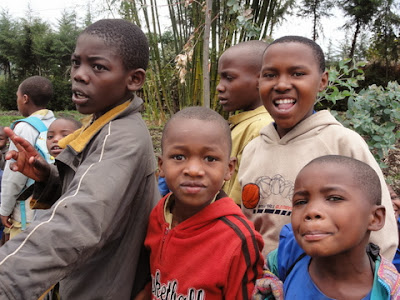Cape Town
Initially arriving in Cape Town was quite a come down. The time on safari and then in Rwanda was very action packed. The plan was to have some rest and relaxation in Cape Town before the long trip back to Melbourne.
Cape Town was very cold, wet and windy. We stayed near the Victoria and Alfred Waterfront. The hotel was very busy and didn't have the room we'd reserved available until the next day. It was back to reality in a big way!
On the way from Barcelona to Nairobi Bob had stored the backup for his computer and a fancy pocket knife, that he likes to keep for useful tasks, in the front pocket of his travel case. They disappeared. HINT (never store valuable items in the pockets of your case while traveling!) He was anxious to get another backup to store his computer data which is essential to his consulting work.
So off we went to a large shopping mall - Canal Walk to find an Apple store. It sounded like a good idea to me too. It has 400 shops and I might find an amazing South African outfit to take home for a modest price. Forget it! The stimulus of all the lights, shops, commercialism and wall to wall people was too much. I found it very confronting. We did what we needed to and left. I've had a reaction going to a supermarket after long summer camping holidays at Wilson's Promontory in the past. The one in Cape Town was magnified by several times! Now that we're settled back in Melbourne and I'm used to city life again I wonder how much my brain is coping with sublimely and whether I could put those neurons to better use!
Table Mountain
The next day we took the cable car up Table Mountain and saw and appreciated another side of Cape Town. Table Mountain is a flat topped mountain that forms a prominent landmark over Cape Town. It is about 3 kilometres from side to side on top. There are about 2.200 plants that are confined to the area. It was lovely to walk around and appreciate the flora and fauna as well as the magnificent views.
The cable cars carry 65 people and revolve so everyone gets a good view. It was sunny and warm on top which is typical we're told although clouds can come in and make it very cold very quickly.
Lots of birds like this raven. We briefly saw a beautiful sunbird but could not photograph it.
Lots of proteas were in flower.
Maintenance on the buildings involved some climbing.
One of the things that surprised me was how few people we heard speaking English in Capetown. Most white people spoke Afrikaans to each other although they also seemed to be able to speak English. It is a language that was originally spoken and has adapted from the early Dutch settlers. I had expected that white South Africans would speak English as their mother tongue but this was not the case.
Robben Island
One of our aims in going to Cape Town was to visit Robben Island where Nelson Mandela was interred for 18 of the 27 years that he was imprisoned.
The island is 7 kilometres off the coast of Cape Town. Tour boats go frequently - weather permitting.
Robben Island was used as a prison from the end of the 17th century. It has also been used as a leper colony and an animal quarantine station. It was used as a prison for political prisoners and criminals again from 1961 until 1991.
There was limited opportunity to walk around as most of the tour is on buses. We stopped at this limestone quarry where Mandela toiled nearly every day for 13 years. On their short breaks they sheltered from the sun in the cave behind. He and other prisoners from the anti-apartheid movement used their time to teach each other things including literature, philosophy and political theory. It was described as one of the great universities of the world. The pile of stones in the middle was stacked by ex-prisoners including Mandela when they visited later to commemorate their stay on the island.
Life must have been very tough working in all different weather conditions in this harsh environment.
The governor's house.
Ex political prisoners give talks about their time as prisoners as part of the tours. Our guide was at Robben Island for about 8 years. Mandela was there at the same time. He spoke about how many of the political prisoners came from different organisations - some were more militant than others. They all showed respect to their elders whom they admired greatly. They were often punished for perceived disobedience but gained great support from their unity. He said that Nelson Mandela taught them not to take revenge on the guards and their enemies.
We were told that Robben Island is now seen as an island of hope - not misery. It is inspirational that the political prisoners never wavered from believing that South Africa could be a different place and that apartheid could be abolished. UNESCO World heritage Committee has marked it for "it's triumph of the human spirit."
There were several black South Africans on the boat returning with us. They were clearly part of a group and were finding the experience to be very emotional. Part way through the 45 minute trip one of them got up and suggested that they sing a song. Within seconds they were up singing and dancing in the aisles in a very moving display. We discovered that they were members of the African National Congress (ANC) - Mandela's party. There will be national elections for a new president in 2014 in South Africa. They continued singing and dancing until they left the boat.
I spoke to a boy aged about 16 who was sitting near us and with the party who was singing. He did not get up to sing. I asked him why. His answer was interesting. He said that's what they needed to do years ago to change the country. Things are different now and it's not necessary anymore. In his eyes apartheid is over and it's the future that's important. I'm not sure if it's that clear cut as most blacks in South Africa remain marginalised. However it was interesting and inspiring that he thinks that the battle has been won.
We had a lovely seafood dinner on the Victoria and Alfred wharf for our final night before flying back to Australia after a wonderful holiday.



























































